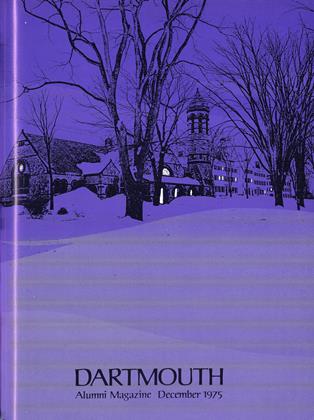Balaban & Katz. If you're that certain age or beyond, the names will ring a bell, conjure up recollections of early days of movie palaces, when the flicks were entertainment rather than Art.
Balaban & Cats. No matter your age, they're names to conjure with for sound that's irresistibly rhythmic, for music that's entertainment rather than anguish, intellect, or social protest.
Above the doorway of 144 West 54th Street in New York, a big green banner bears another name from time-gone, an echo of the great days of jazz. "Eddie Condon's," it proclaims. Inside on the bandstand, LEONARD J. BALABAN '51 heads a six-man combo called the Cats.
The pun is intentional. Balaban, known as "Red" for the most obvious of reasons, is the son and nephew of the men who founded a chain of midwestern movie theaters about the time of World War I. His father Barney Balaban was president of Paramount Pictures from 1936 to 1964, when he succeeded Adolph Zukor as chairman of the board.
Transferring to Brown in 1949 "because Providence was reputed to have more women than Hanover," Balaban proved the point by meeting and marrying Mickey, a Pembroke student now his wife of almost 25 years. Abandoning a certain future in his father's footsteps, he took off in almost the opposite direction: to the Florida panhandle and the unlikely occupation of cattleman. For 15 years he raised registered Aberdeen Angus breeding cattle, meanwhile making his mark as a musician, playing banjo, string bass, and tuba with local groups and appearing as a solo entertainer.
In 1967 music won, and the Balabans moved back north to Connecticut. For a time, Red worked as a sideman, then gathered a shifting group of Cats, which performed single engagements at country club dances and the like and regular stints in New York and suburban clubs. At weekly appearances at Your Father s Mustache, site of the old Greenwich Village Nick's ("the valhalla of traditional music," according to RollingStone), Balaban & Cats attracted rave reviews and guest appearances by such jazz men as Gene Krupa, Wild Bill Davison, and the late Eddie Condon, who gave Red his first guitar. When he opened his own club last spring - with four cats who had played with Condon - its name was born as logically as that of the combo.
Five nights a week Red plays tuba and bass and sings a little, backed up by the cats on clarinet, trumpet, horn, drums, and piano. No music-rack or score clutters the bandstand, and waves of applause follow front-and-center vocals and solos on clarinet sweet enough for tears, clear-toned trumpet, and fluid trombone. The spot shifts to Red as, eyes half closed, he puts a thumping bass or mellow tuba through its paces; then to exploding drums and bright piano improvizations. Middle-aged listeners mouth with the vocalists the familiar lyrics of "You Ought To Be in Pictures," "Somebody Loves Me," "Ding-Dong Daddy From Dooma," and "It's a Good Life." Between sets Balabah becomes the focus for everyman's nostalgia, as his patrons stop by his table to recall "I heard Krupa back in ..." or "Remember Goodman at . ..?"
But the young too, nurtured on the blast of rock or the schmaltz of country/western, are as caught up as their elders in the rhythms of Balaban and his cats. "Rock was a rebellion," as Red sees it, "and now they're rebelling against rock."
"Dixieland for dancing" has been a semi-slogan of Balaban's combo, and he regrets the restrictions running the club has put on appearances at parties. His is a jazz recaptured from the hardcore buffs who intellectualized it into a cult. I really don't like to play for the experts," Red claims. Far better, the audience which comes to be entertained, for the sheer joy of it, by the sound and the rhythm.
A sense of joy pervades Eddie Condon's, mutual to musician and listener. For Red Balaban, gathering his cats and picking up the beat with a "one, two, three, four ...," it's a good life.
 View Full Issue
View Full Issue
More From This Issue
-
 Feature
FeatureQuite Contrary
December 1975 By SAMUEL PICKERING -
 Feature
FeatureThe Assault On Quebec
December 1975 By LEWIS STILWELL -
 Feature
FeatureHigh On Your Dial
December 1975 By DAN NELSON -
 Feature
FeatureDartmouth Radical Union
December 1975 By M.B.R. -
 Class Notes
Class Notes1959
December 1975 By DOUGLAS WISE, BARRY R. BLAKE -
 Class Notes
Class Notes1950
December 1975 By JACQUES HARLOW, EDWARD TUCK II
M.B.R.
-
 Feature
FeatureDartmouth Radical Union
December 1975 By M.B.R. -
 Article
ArticleDesigns for Living
February 1976 By M.B.R. -
 Article
ArticleEqual Opportunity: efforts to make it more equal
June 1976 By M.B.R. -
 Article
ArticleDistrict Attorney
December 1976 By M.B.R. -
 Article
ArticleA Household Word Among the Voiceless
MAY 1978 By M.B.R. -
 Article
ArticleMan of the Cloth
November 1978 By M.B.R.








